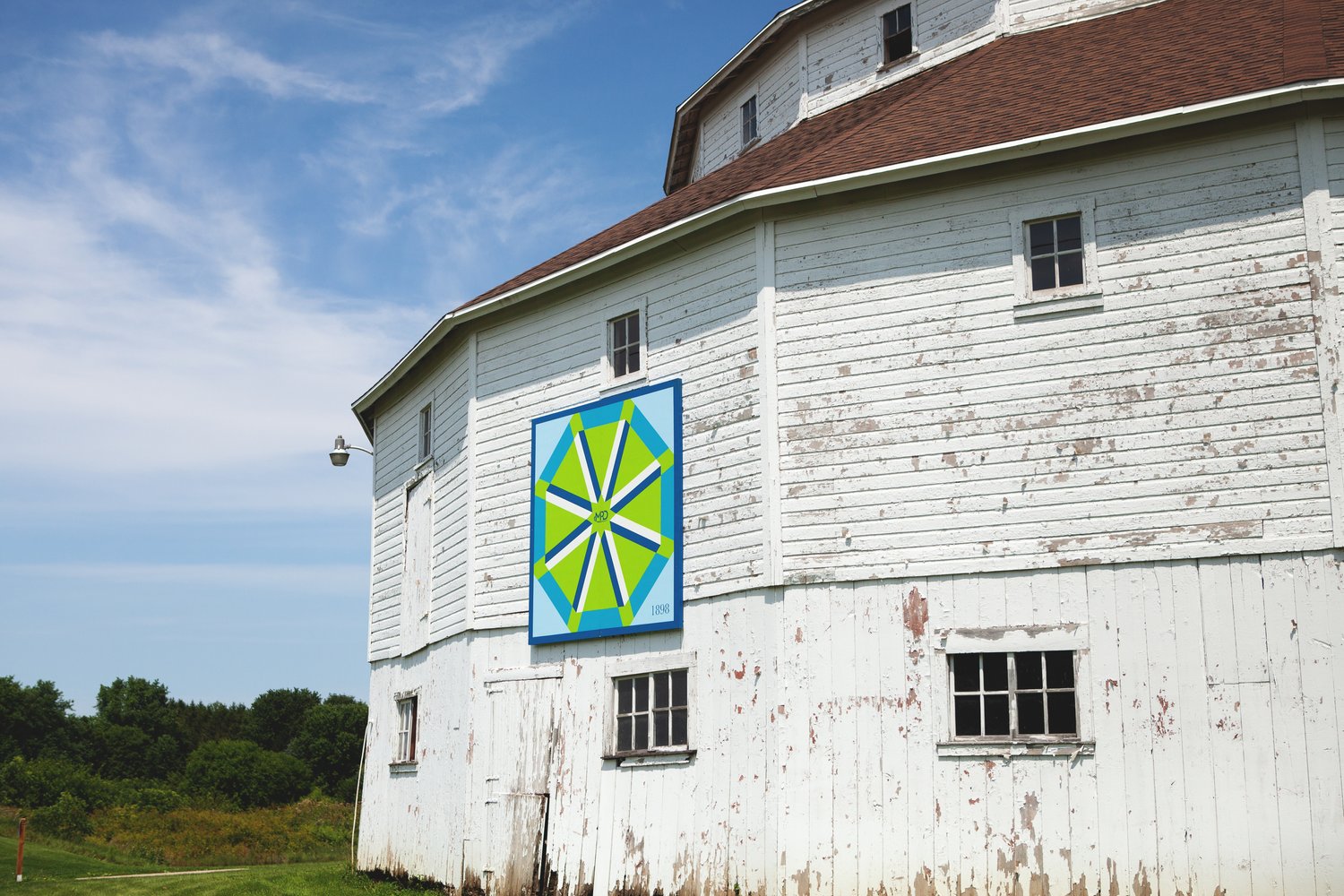-
What do Artists, Painters, Fabric Quilters, Historical Preservationists, Tourists, Photographers, Farmers, and Barn Quilters all have in common? It all begins with a quilt pattern, a color pallet, a history, pride of place, and a desire to create.
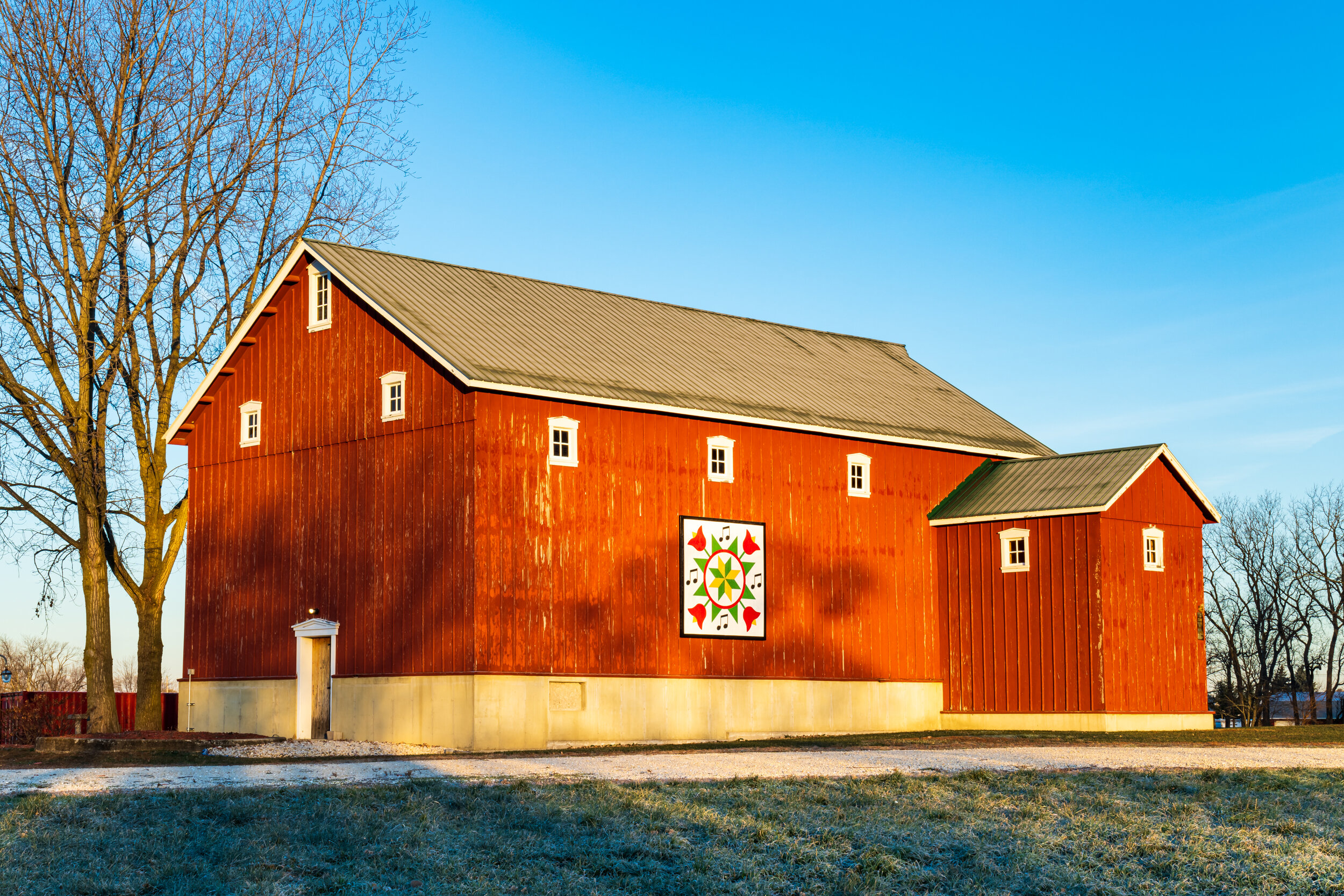

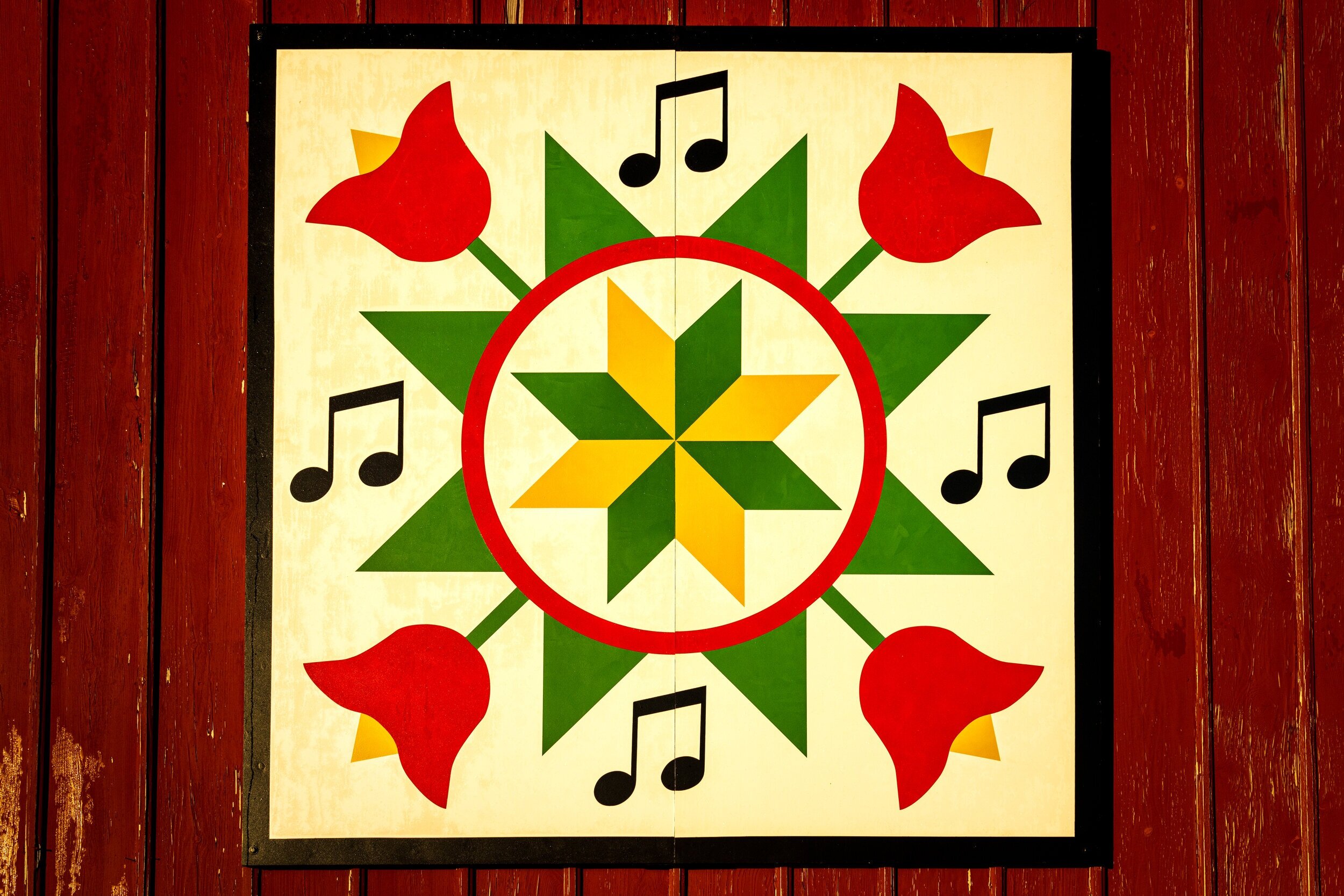
Brashler Barn | Lockport, IL
The house was probably built between 1840 and 1856. The barn was originally constructed in 1914. It is shown in the Will County Structural Survey of Homer Township from 2002. It was a dairy barn, equipped to milk cows on the first floor and hay storage on the second floor. The other buildings on the property included the milk house, chicken coop, 3-seat outhouse and hog barn. The hog barn was knocked down by a micro burst recently.
The house and barn were in ill-repair when Lois purchased them in 1983. Lois did the first house rehab adding new in-door plumbing, electric, and insulation. At that time it consisted of the front 2 story and adjoining one story kitchen. In 2001 an addition was built to house Lois’s new husband Mike and a larger family.
One late evening in the 1980’s, Lois had the good fortune to meet someone who restores old barns, even though she did not have the funds at the time. Fast-forward to 2001. The Barn had suffered many years of wear and tear due to the elements. It was either do something or lose the barn.
So, from 2001 to 2013, they turned the dirty, dairy barn into a place where family and friends can gather and enjoy bluegrass music on a warm summer night-or perhaps bring their own instrument and jam with us and our friends outside to watch the sun go down, or stroll through the vegetable and flower gardens filled with heirloom family plants.
The combination of Mike’s love for music and Lois’ love of art, landscaping, and preserving history has made the barn our passion and joy. It’s stood here for over a century, watched the beginning of towns, the underground railroad, the building of Route 66, and replacement of cows with bluegrass! We hope to continue to be good stewards of our barn, and share it with others, for as long as we are blessed to be able to live here. The Barn Quilt on the Brashler Barn is a unique blend of a star pattern, a wagon wheel, with tulips and musical notes. This Barn Quilt was partially sponsored by Roger and Dianne Ross. It was painted by the Arts Guild of Homer Glen and delivered in 2020.
Barn Quilt Design: Star pattern with Wagon Wheel, Tulips, Musical Notes
Concerts are invitation only, for friends of the Brashler’s.



Bump & Grind | Homer Glen, IL
Bump & Grind Auto Body, Inc. is a family-owned and operated business that was established in 1982 by husband and wife, George and Bonnie Flondor, and their two sons. Since opening its doors, Bump & Grind has been providing customers with quality collision repairs. Being that it is a manufacturer-certified facility, this organization aims to assist any and all customers in need of vehicle repairs.
Additionally, Bump & Grind is classified as an “I-Car Gold Class” facility, which signifies the highest certification a body shop can be granted within the automotive repair industry. This solidifies Bump & Grind’s status as a shop that adapts to and keeps up with the education and techniques required to satisfy the demands of the everchanging industry.
Always having a passion for classic cars and hot rods, current owner and president, Kevin Flondor, introduced Bump & Grind’s restoration division to the business in 2010. This addition has allowed Kevin, alongside his highly talented team of technicians, to continue bringing classic cars back to their original glory in the way that he and his dad once did in their home garage.
Bump & Grind Auto Body has earned recognition within the community for not only its top-notch repair services, but also for its outstanding customer service. They hold their value of family at the center of their operations and strive to treat all customers as one of their own. This, combined with their drive to uphold the highest-possible repair standards, allows them to maximize the customer experience and has led to Bump & Grind being named by community members as the “Best of Homer Glen” for several consecutive years.
Going beyond the local community, Bump & Grind has gained acclamation on the national scale through the car show circuit. From calendars appearances to magazine covers, their state-of-the-art restoration projects have attracted appreciation at numerous car shows across the country.
When the opportunity to collaborate with the Arts Guild of Homer Glen and participate in the Will County Barn and Quilt Trail presented itself, Kevin was eager to get involved. He holds great admiration for the unique sense of style that his parents (George and Bonnie) instilled in him growing up, much of which resonates with the western themes present in the works of this charity organization. He even drew inspiration from this type of décor within the remodel of his facility that was completed in 2019.
Bump & Grind Auto Body, Inc. recently celebrated its 40th anniversary in 2022, and this organization accredits much of its success to its loyal customer-base and supportive community. On behalf of Kevin and the entire team at Bump & Grind, thank you to the Arts Guild of Homer Glen for allowing us to take part in this movement. We look forward to any opportunity to get involved in our community and are eager to continue providing our best possible care and service to all who walk through our doors.
The Arts Guild delivered this Barn Quilt in Spring of 2023.
Barn Quilt Design: This Way.

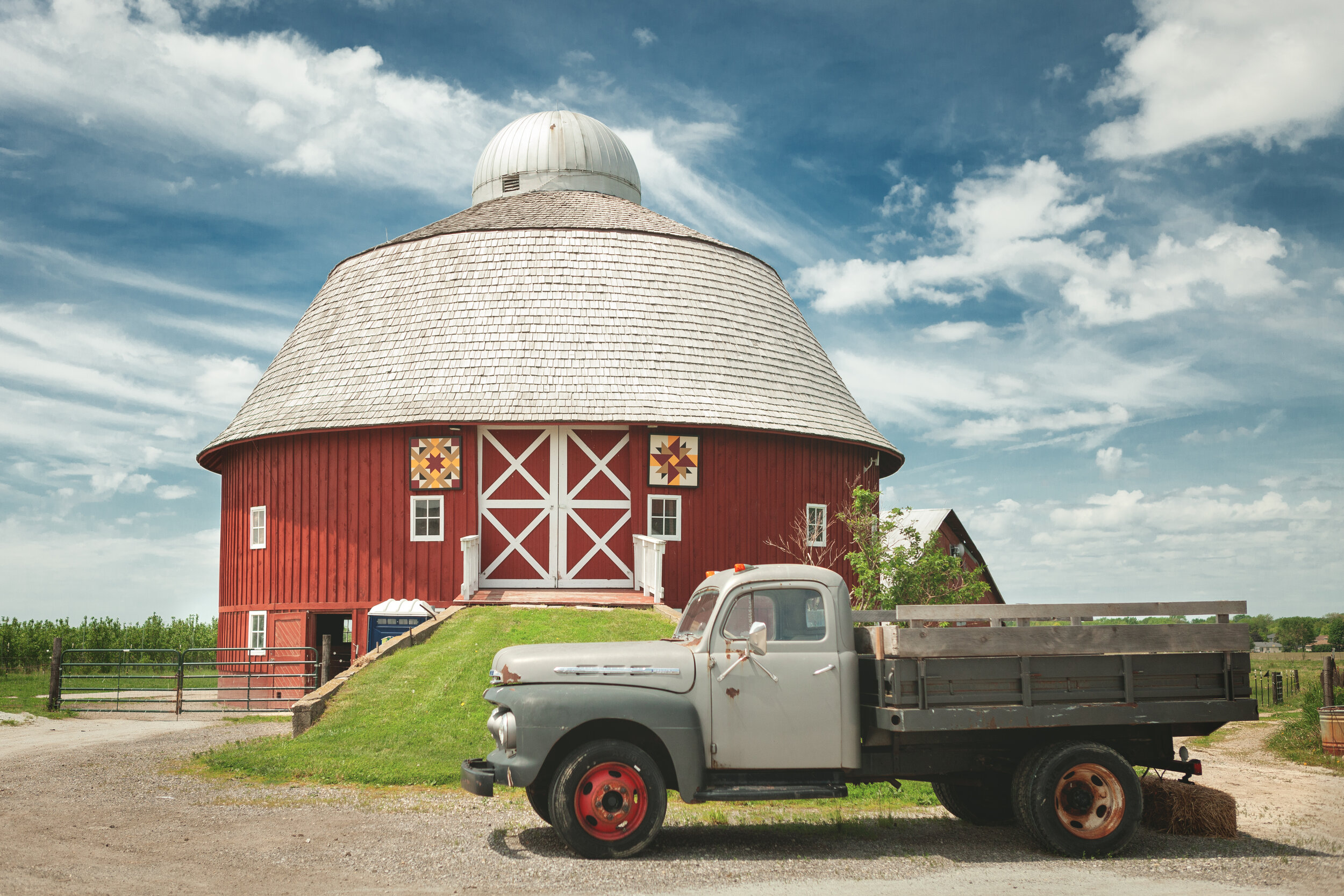
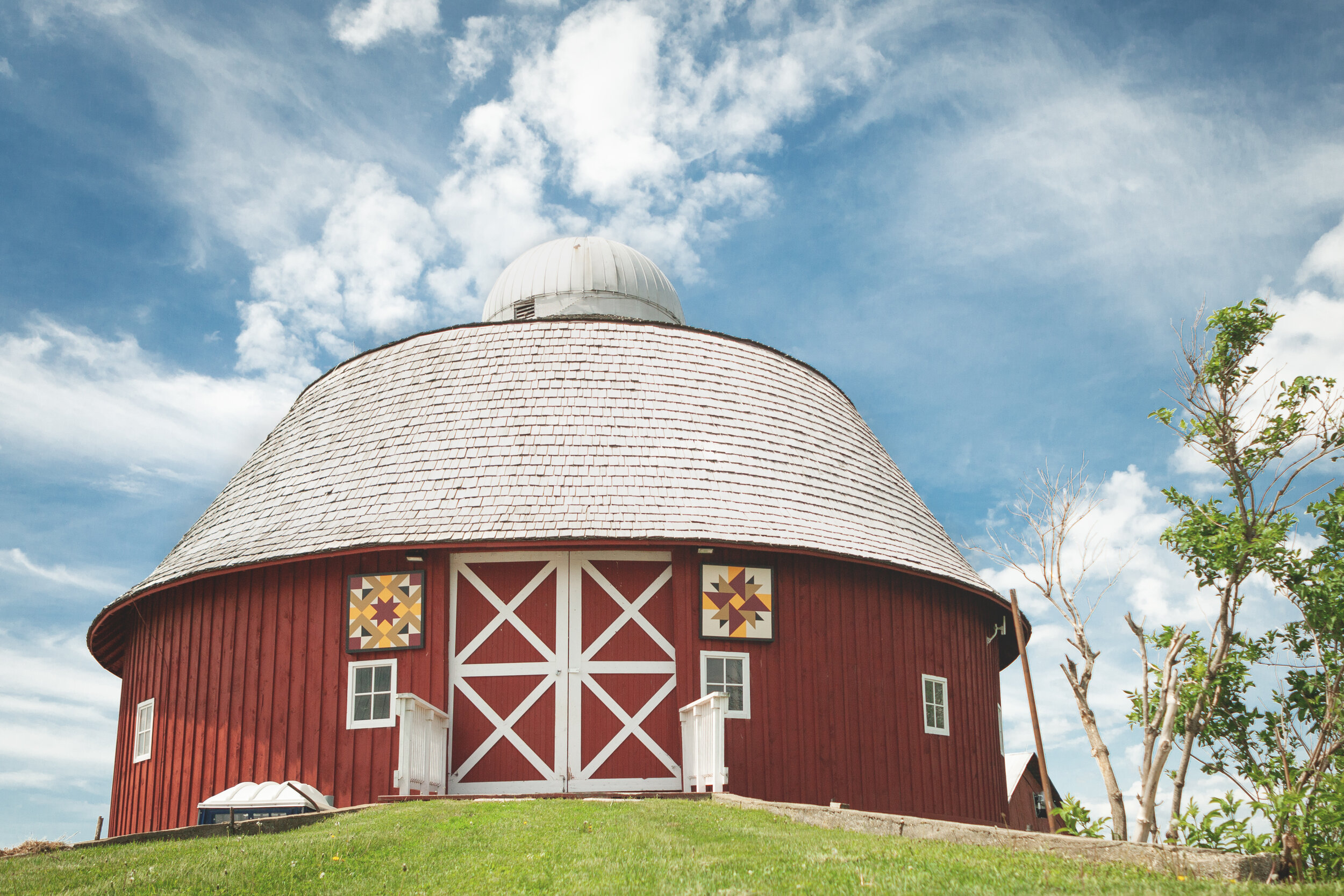
Crosswind Farm | Manhattan, IL
The land was first purchased from the government in 1836 by the Bronson family. They were eastern capitalists that made their fortune in commercial banking and later continued to expand family wealth by land investments. Not much is known of the farmstead until Daniel and Sara Cockle bought the property in 1893. Wilbur & Marie Brookman were prominent landowners in the region and owned it next.
Crosswind Farms is home to one of two round barns in Manhattan Township. The round barn, replaced a barn that was destroyed by a tornado in May 1917. The round barn was finished by 1919. It is indicated to be a Gordon-Van Tine mail order; model #214. The original Cupola on the barn was replaced by the dome you see today sometime after 1955.
The farm was purchased in 2012 by Tom & Dawn Levis from the Brookman estate. It was transformed from traditional regional farming to a u-pick farm and farm stand. When in season you can pick strawberries, raspberries, blackberries, concord grapes or purchase fresh produce. The barn was restored by the Levis family 2016-2017.
The property also features a one room schoolhouse. The schoolhouse was known as the Manhattan Center School. It was built in 1959 and located on the northwest corner of Manhattan Monee & Cedar Rd. It was moved to its current location sometime after 1955.
Because of the curvature of the barn, there are two barn quilts. The Double Aster and the Magic Carpet are painted using the same colors to tie them together. The Barn Quilts were painted by The Arts Guild of Homer Glen and delivered in 2020.
Barn Quilt Design: Double Aster and Magic Carpet
This location will have two Barn quilts because of the curvature of the Round Barn.

Homer Township |Homer Glen, IL
This Barn Quilt is currently in the Homer Township Administration Building. it will be hung on the Event Center upon completion. The Barn Quilt was painted by The Arts Guild of Homer Glen and delivered in 2024.
Barn Quilt Design: Maze

Homer Honey Farm | Homer Glen, IL
Homer Honey Farm was established in 1999 as a family-owned business. There is a roadside produce stand that is open from mid-July through the Halloween season. In addition to honey, they grow peaches, watermelon, cantaloupe, tomatoes and other vegetables. This small farm is a favorite with locals for fresh honey and produce.
This Barn Quilt was painted by Craig Olsen for The Arts Guild of Homer Glen and delivered in 2023.
Barn Quilt Design: It Takes A Village
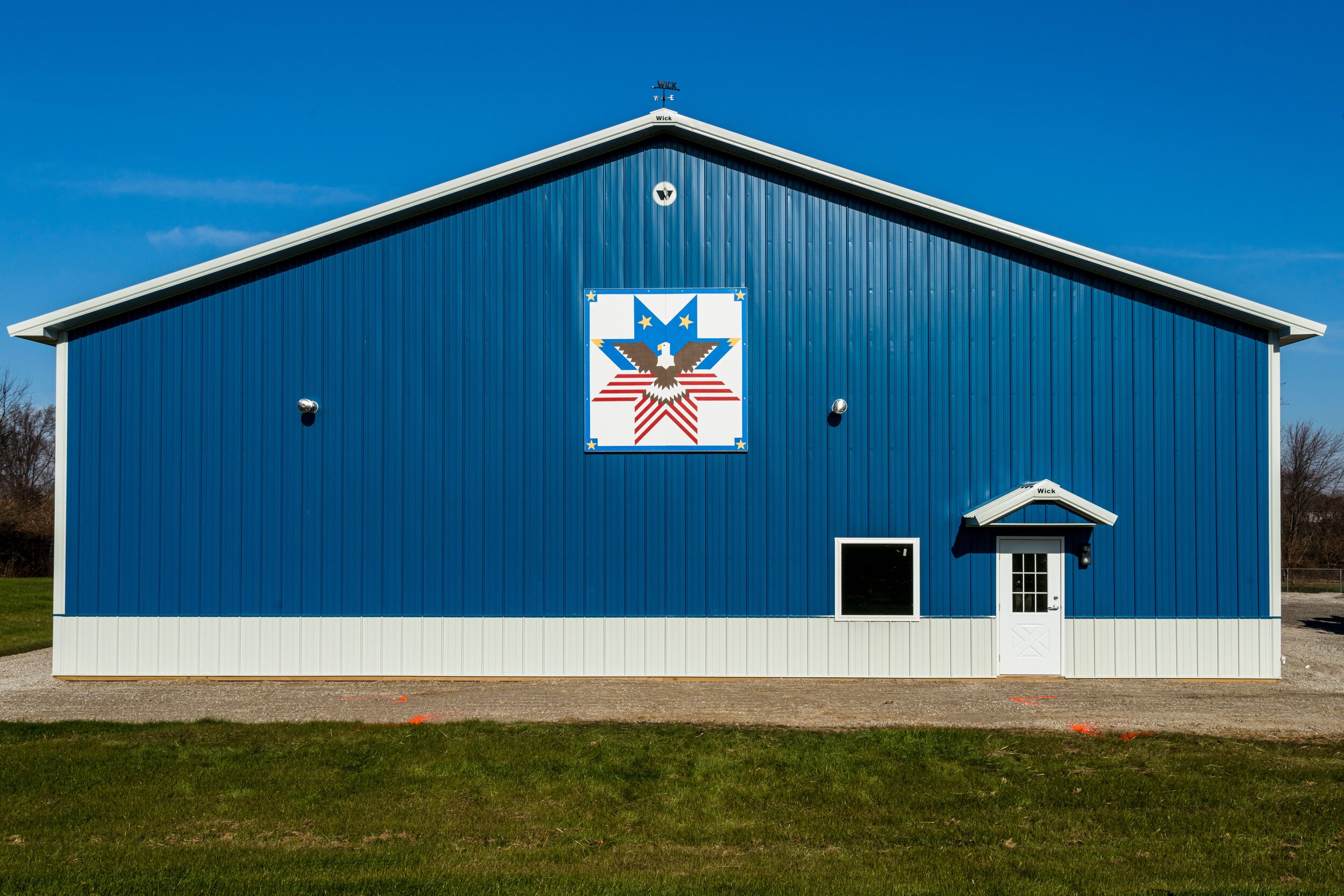

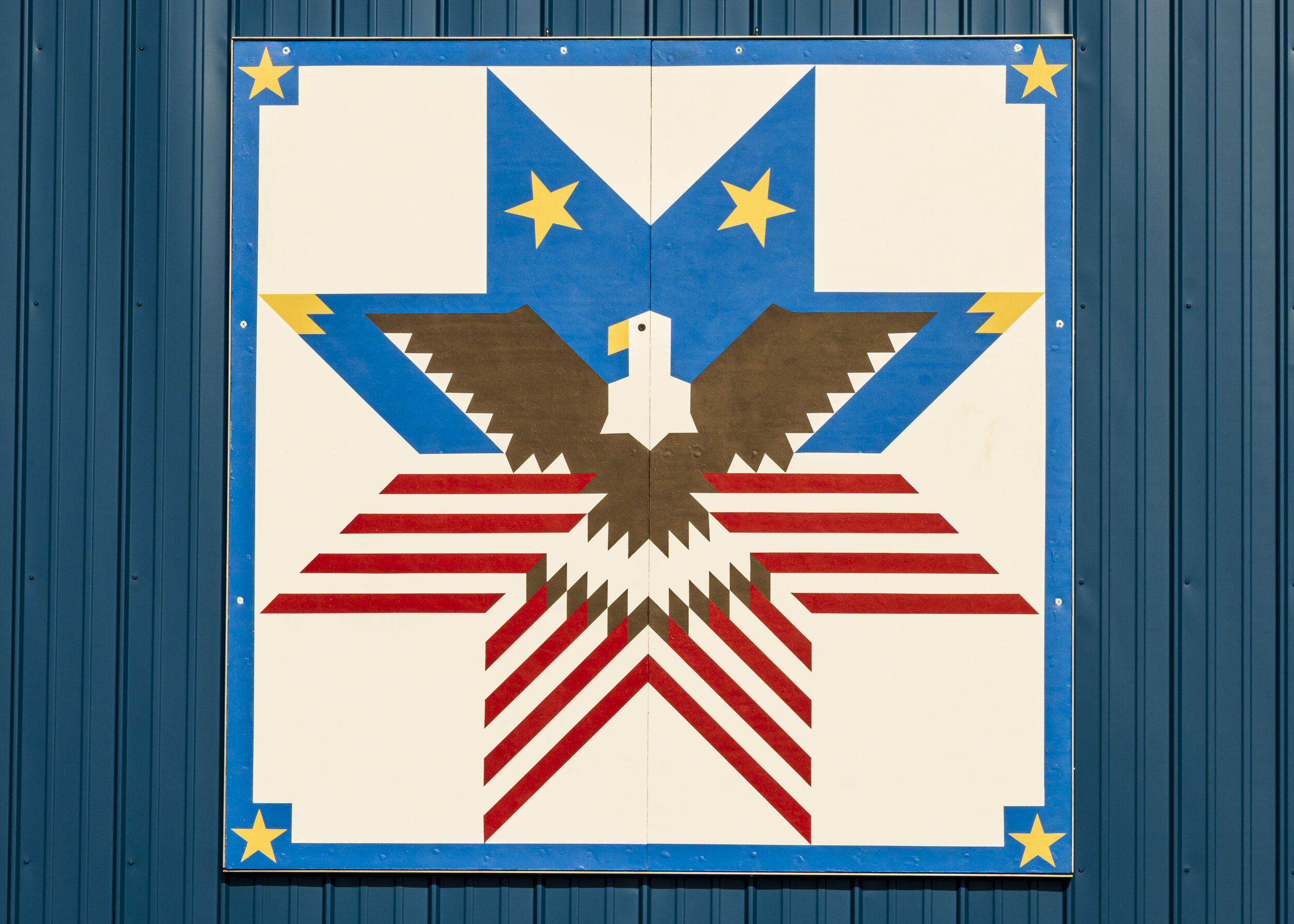
Homer Township Road District, Homer Glen, IL
Homer Township was established on April 21, 1862. Homer was one of the first Will County Townships to be settled. The township started with 109 residents and 26 houses. Today, the township consists of over 24,350 residents and over 13,400 housing units. Homer Township was named by Alanson Granger in honor of his native home, Homer, New York. Homer Township is located between Orland Park, and the historic cities of Lemont and Lockport.
According to the website, www.homertownship.com,
“Homer was one of the first Will County Township to be settled, due to its excellent stand of timber. The early pioneers moved into timber areas, clearing the land for farms, and using the timber for building houses, barns, and fences. Homer’s land was rolling enough to provide good drainage, yet not hilly enough to encourage excessive erosion of the rich topsoil.
One of the townships original residents, John Lane, is credited for creating the first steel plow. This remarkable accomplishment in agriculture is noted on a marker located at the northeast corner of Gougar Road and 7th Street. Lane’s invention is credited with making it possible to cut through dense roots thus allowing the production of agricultural crops.
Initially the township met at a kitchen table. Various tool sheds and barns were used to store highway equipment. A Town Hall was built at 16057 S. Cedar Rd in the late 1800’s. A Highway garage facility was built next to it 1969. The current property of the Township offices and the Highway Department was once part of the Ludwig Farm. A Highway Building, with offices and garages, was built in 1991 at 14400 W 151st St., Homer Glen.
A history of Road Commissioners from George Bump, through Dutch Hostert, George Zalecki, Dick Winke, John Donahue, Frank Dunn and Mike DeVivo reads like the first families of Homer Township.
The “American Eagle” Barn Quilt hangs on the building, built in 2020, at the location on 151st. It is a modern pole barn or post-frame building. Mike DeVivo wanted a patriotic themed work of art. So the Arts Guild of Homer Glen created American Eagle and delivered it in 2020.
Barn Quilt Design: American Eagle
Patriotic themes are very popular with Barn Quilt aficionados.

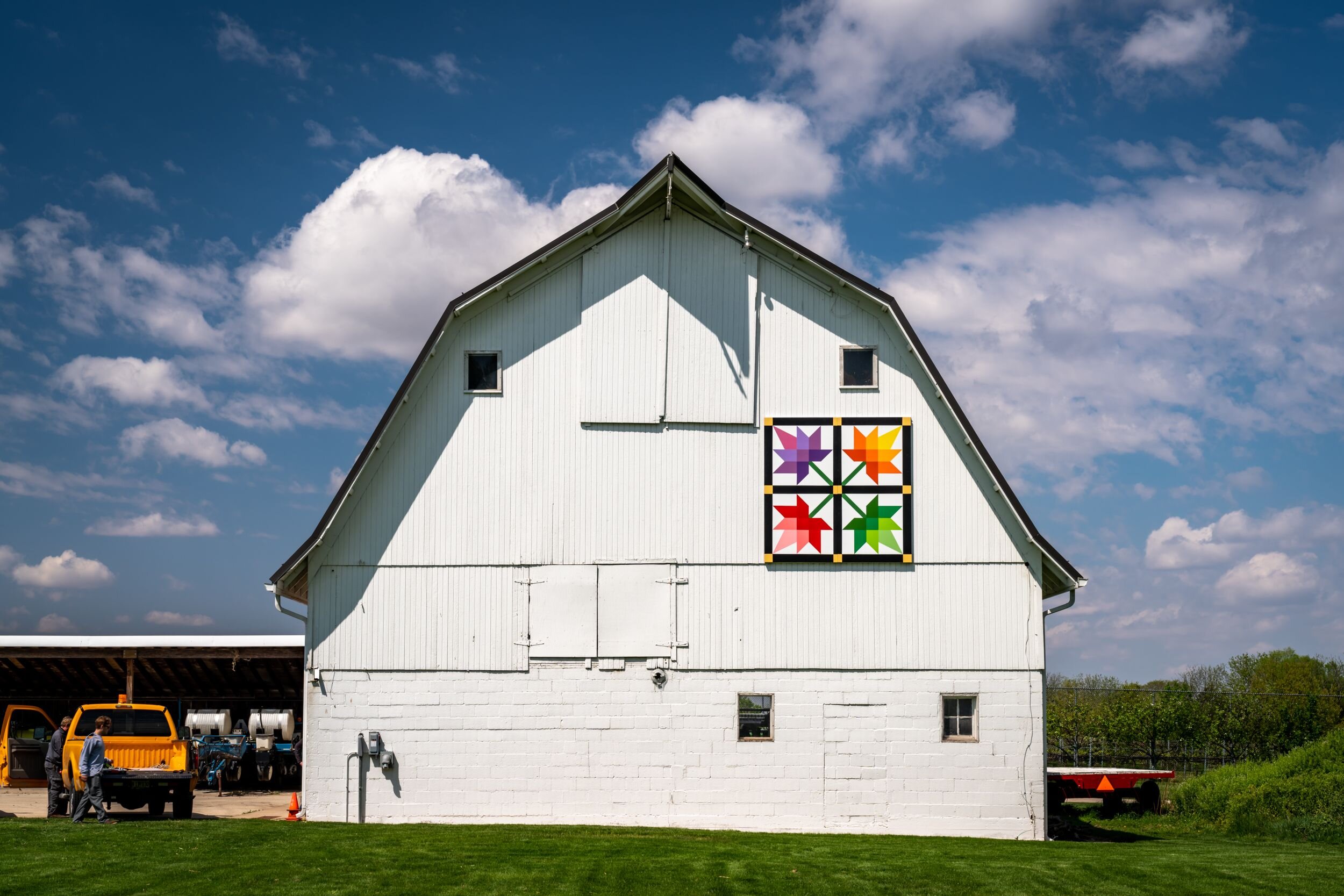
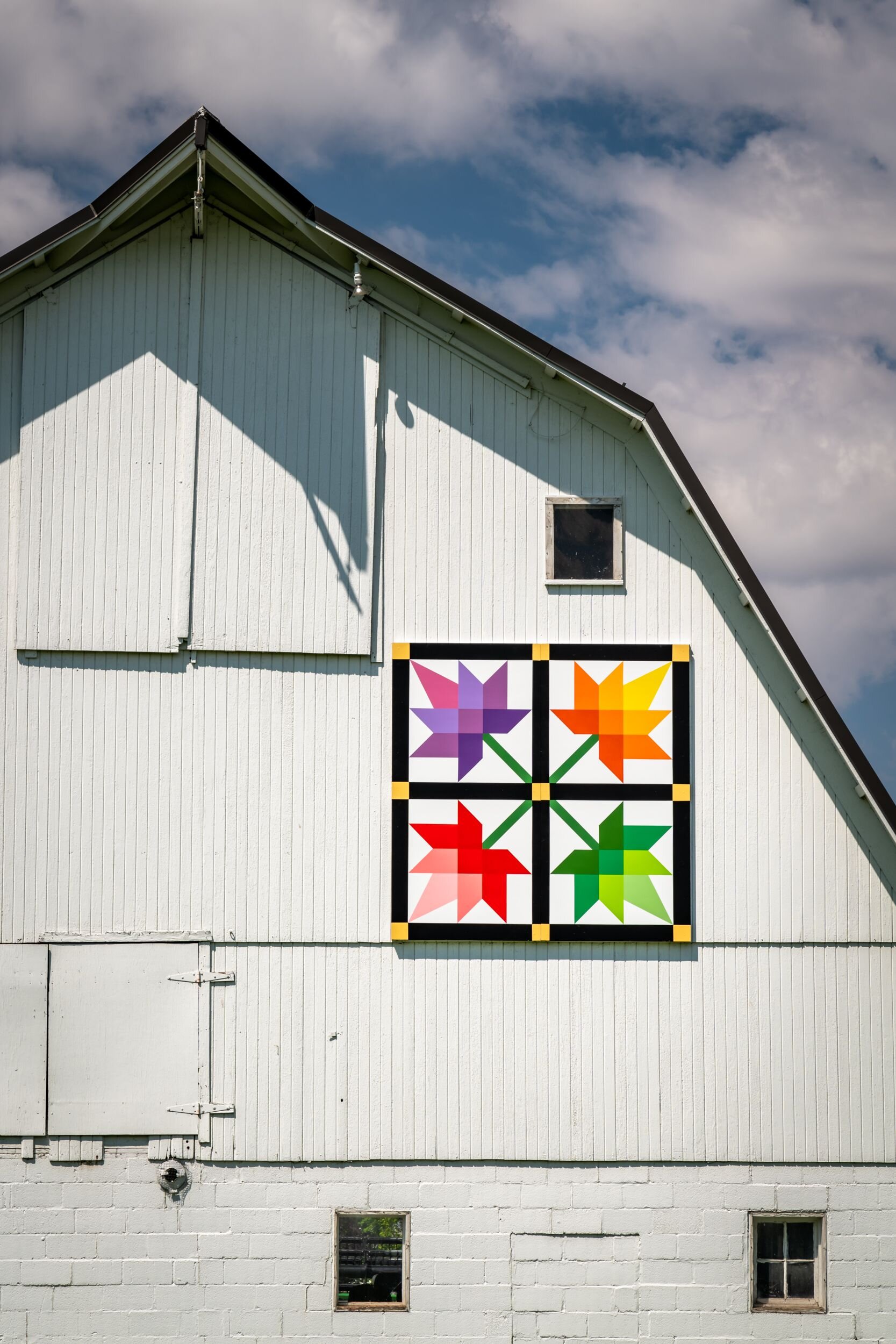
Joliet Junior College | Joliet, IL
Joliet Junior College has a long, rich history of serving the community by providing quality education at an affordable price. J. Stanley Brown, Superintendent of Joliet Township High School, and William Rainey Harper, President of the University of Chicago, founded JJC in 1901 as an experimental postgraduate high school program. It became America’s First Community College. JJC's enrollment was only six students at the time the college first began. Today, the college serves more than 27,000 students in degree, certification and lifelong learning programs. The 1,442-square-mile district serves a population of more than 700,000 in Will, Grundy, Kendall, LaSalle, Kankakee, Livingston, and Cook Counties.
JJC purchased two farms from the Richards family, in 1967, for a total of about 350 acres. There were two complete farmsteads located at the Houbolt site. The south homestead was located where the current greenhouse facility now stands. The north homestead was about 75 yards north of the main entrance to the college. The only remaining original building is situated near the JJC greenhouse. It sits on the west side of Houbolt Ave.
In the early 1970’s, the Richards family home, which stood on the north side of the greenhouse parking, lot was used as a private residence and later used as a conference center. In the 1980’s, the chicken house became the office for the grounds department. Since there was a milk house just west of the chicken house, it is assumed that the barn was used as a dairy barn. There was another barn located west of the present classroom area of the greenhouse complex that was used for junk storage until it was demolished.
The barn was used by the grounds department for storage until the agriculture department finally took it over for storage of ag related supplies and equipment.
Elmer Rowley, college dean from 1947 to 1967, is credited with creating programs that included the educational needs of the entire community and not just four-year degree transfer programs. Alongside with faculty, Rowley developed several new transfer programs including agriculture. This new program was the first of its kind offered at an Illinois junior college. (p.54 Joliet Junior College 1901 to 2001: A Pictorial History of America’s Oldest Public Community College, by Sterling, Robert E.)
On February 6, 1968, with much help from Max Kuster, the Agriculture Department Chair, it was announced that the Richards farm on Airport Road (now Houbolt Road) had been selected as the site for the new campus. Students arrived on September 22, 1969 to the new campus location. Mr. Kuster is credited with creating the agriculture economics, dairy science, crop production and principles of feeding programs at JJC. Robert Cottingham was hired in 1968. He is credited with developing the college’s horticulture program.
“A long-range goal of the agriculture faculty was realized in 1983 when operation of the 143-acre farm on college property was turned over to the department. Designated as the J. F. Richards Land Laboratory in honor of the family that sold the property to the college. The land is used to supplement classroom instruction. It is used extensively by instructors and students for agricultural research and agronomy demonstrations.
The Barn Quilt created for JJC by the Arts Guild of Homer Glen is a Maple Leaf pattern, and was delivered in Spring of 2021.
Barn Quilt Design: Maple Leaf
The Agricultural Department is the heart of Joliet Junior College.
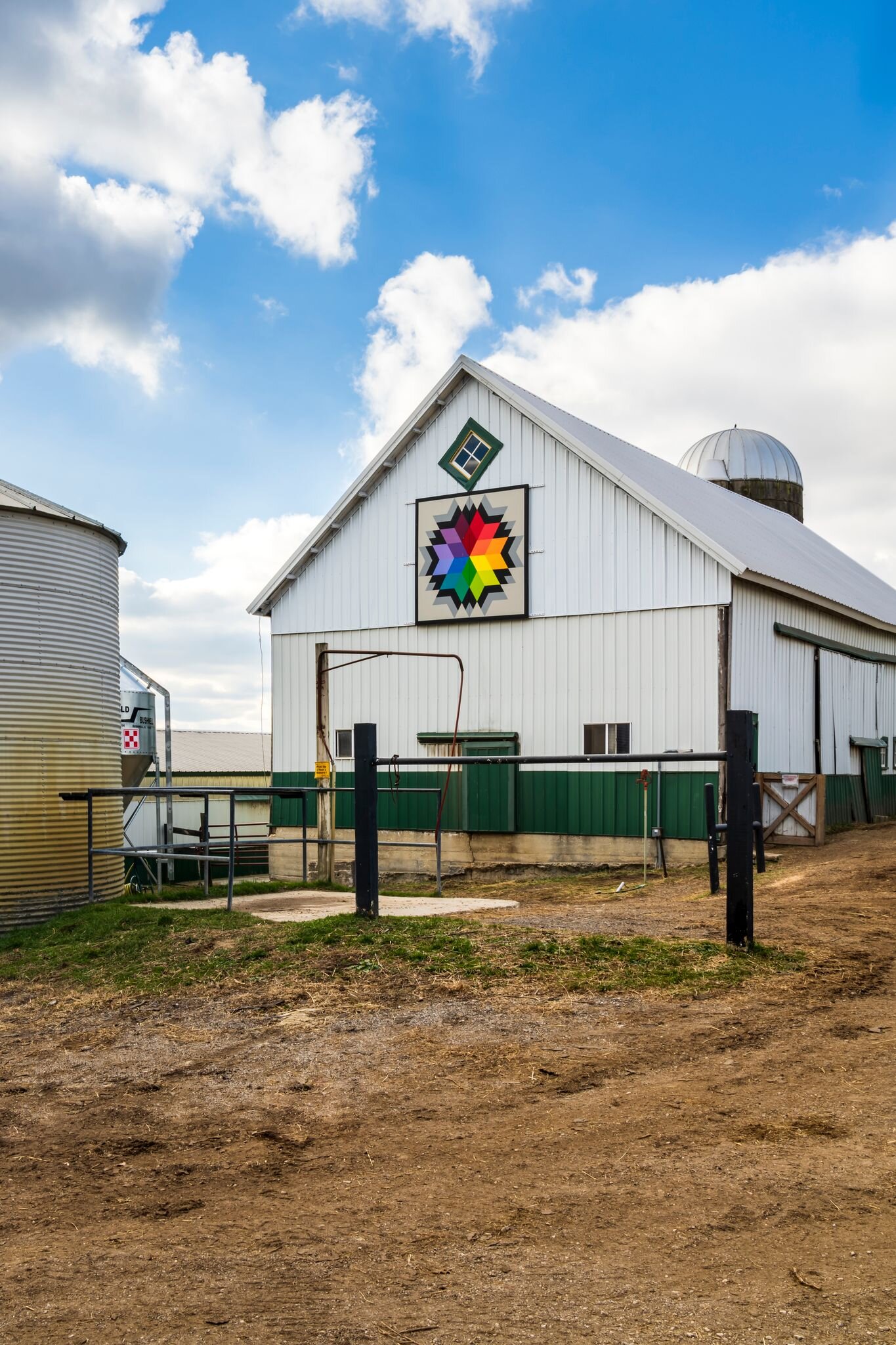

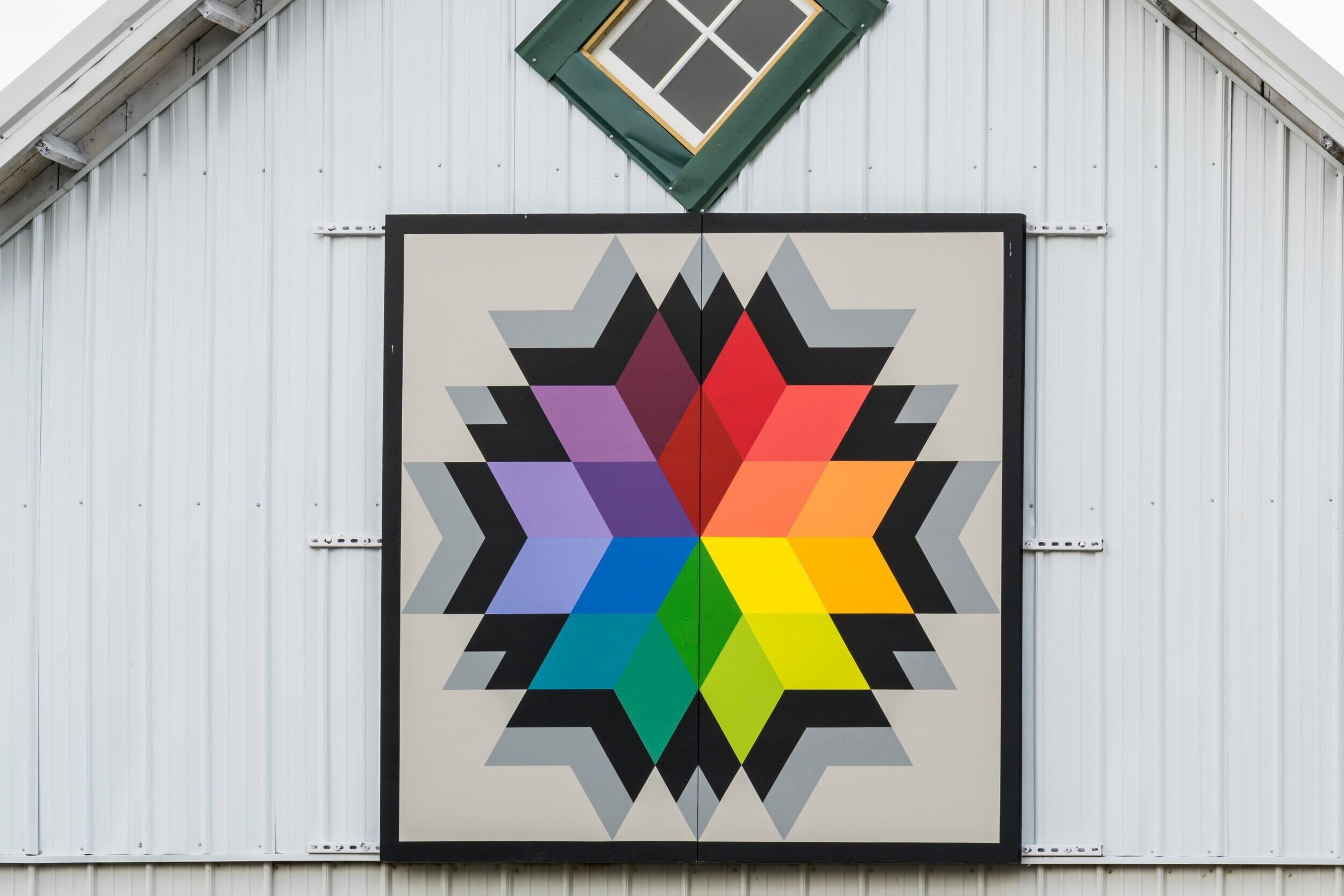
Kopping Equestrian Center | Lemont, IL
The Kopping Farm Equestrian Center is located at 12300 115th St. in Lemont, IL. As true of many farms in the area, it was settled by German immigrants. The rolling terrain reminded them of their homeland. In 1870, Henry Hermes homesteaded the farm. Four generations of the Henry Hermes’ family have worked the soil and tended livestock on this farm. It was passed to Laurance and Laura Mathy, then Harold and Lauretta Kopping and finally, Gerald and Linda Kopping. It has been a dairy farm, a hog farm and a poultry and grain and hay farm. Gerald attended college to become a high school agriculture teacher and started boarding horses in 1984. The farm has expanded into a large scale equestrian center. The Koppings farm 600 acres in Cook and Will Counties, board and train horses, and maintain a small Black Angus herd. Their Barn Quilt Pattern is Gravity and was painted by the Arts Guild of Homer Glen in partnership with the Will County Farm Bureau and delivered in 2020.
Barn Quilt Design: Gravity Color Wheel
“Gravity” is a color wheel as most artists recognize.
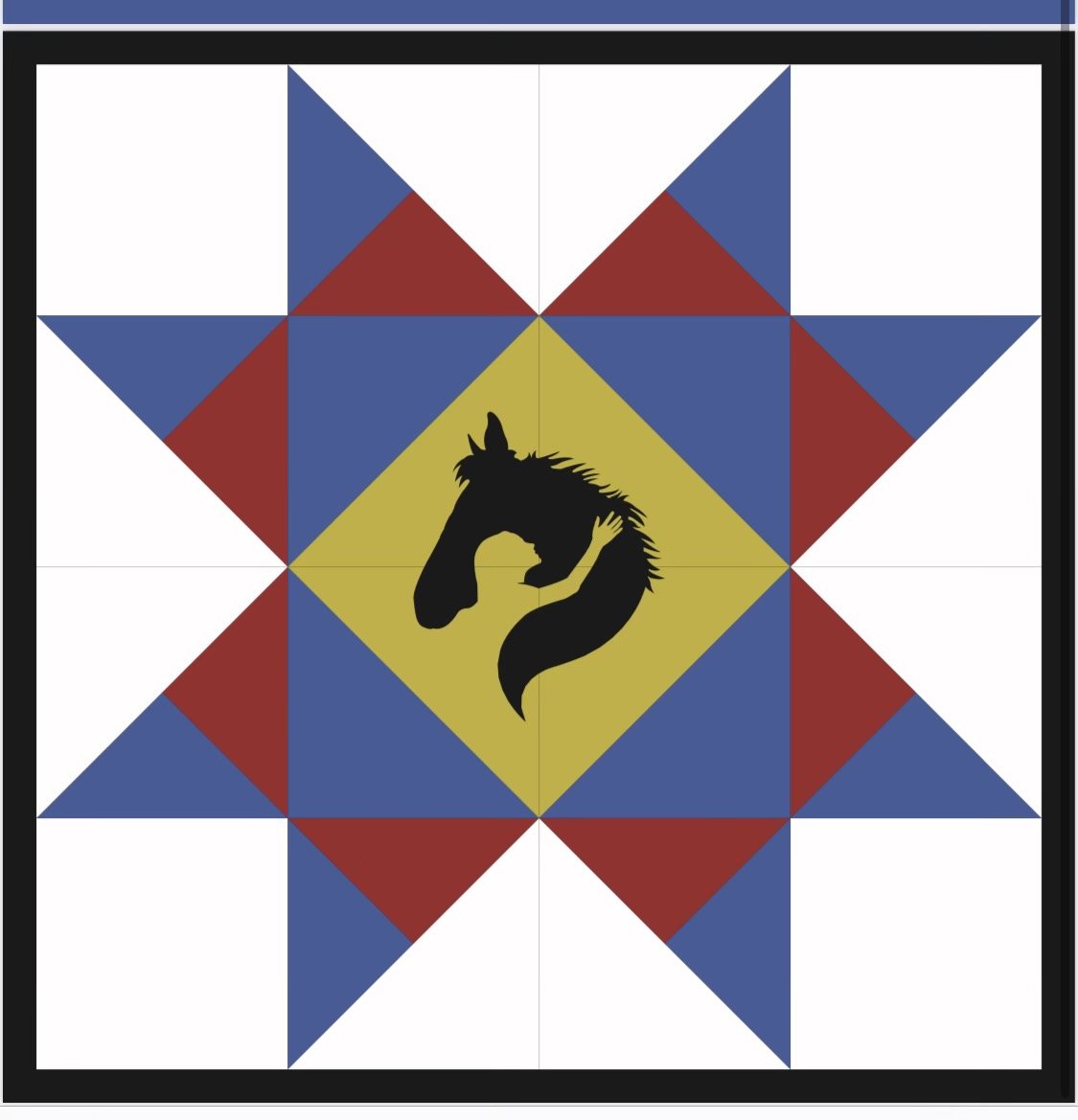

Legacy Ranch | Lockport, IL
The Legacy Ranch, a 501(c)3 Non-Profit Organization, was established in 2017 to provide Equine-Assisted Therapy to the Chicagoland area.They provide PATH-certified therapeutic-riding, Equine-assisted mental health therapy, along with Occupational and Physical Therapy in conjunction with their therapy partners.
Those in need can get the help they deserve even if they are unable to afford the therapy on their own. Veterans groups, foster children and others with special needs will have the opportunity to heal with the horses with the help of the generous donors who have helped make The Legacy Ranch a reality.
Barn Quilt Design: Missouri Star
This barn quilt was delivered in Spring of 2022
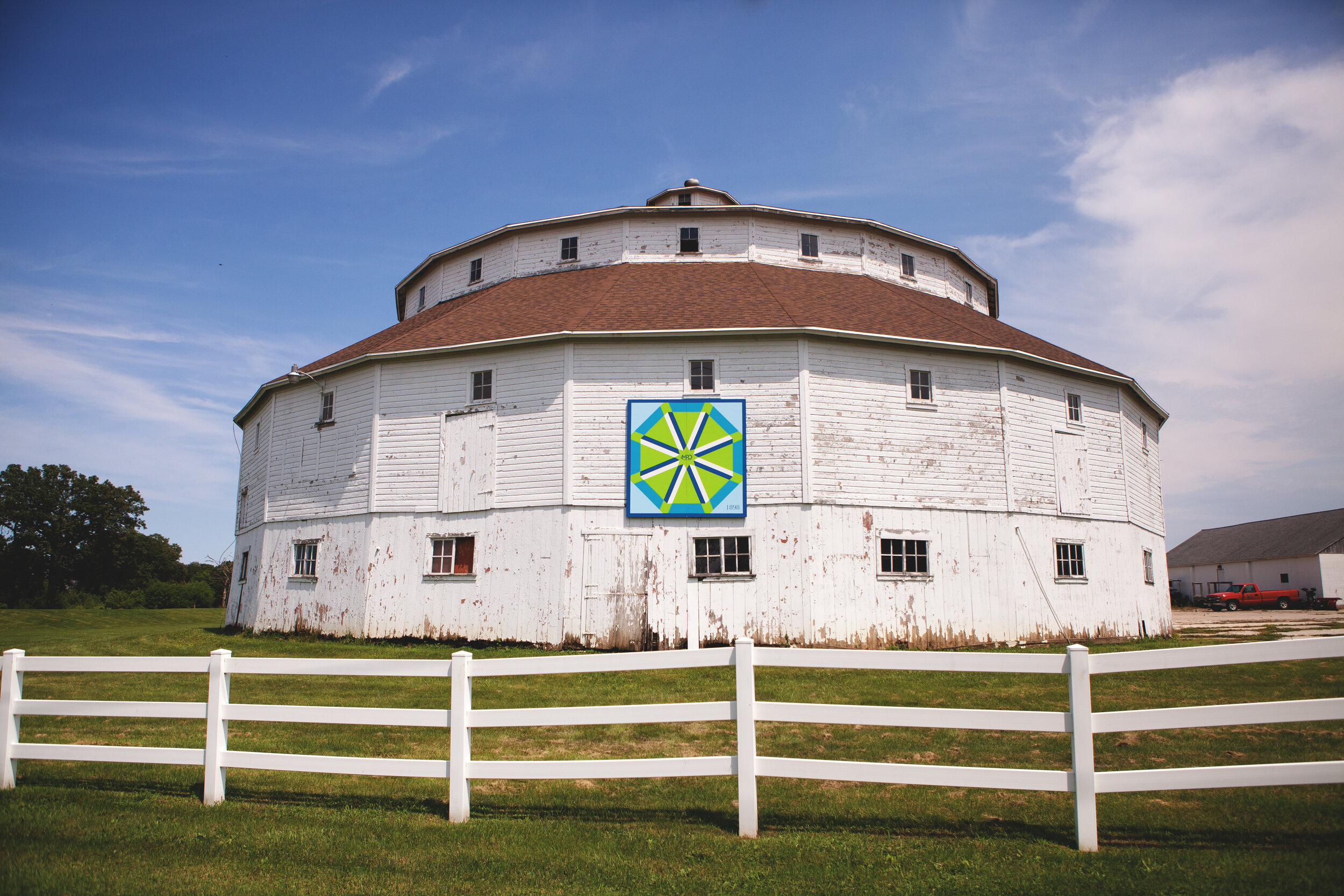


Manhattan Park District | Manhattan, IL
This property is truly a local favorite! The Manhattan Park District purchased this property in 2006. The following information was taken from the Manhattan Park District website.
https://www.manhattanparks.org/parks-and-facilities/round-barn-farm
“Baker-Koren Round Barn Farm is an 87-acre community park located north of Manhattan acquired by the Park District in 2006. Round Barn Farm is home to the historic and county-landmarked Round Barn completed by John C. Baker in 1898, constructed of wood salvaged from the 1893 Chicago World’s Columbian Exposition. The 20-sided polygonal barn remains one of the largest round barns in Illinois.
A true representation of our local heritage, Round Barn Farm was originally part of Five Mile Grove, the primary location of first European settlement in what is now known as Manhattan. Round Barn Farm features not only the historic barn, but also natural areas including an old growth oak grove, Jackson Creek, native plantings, and a pond. The beautiful grounds of Round Barn Farm is home to weddings, family parties, and our Round Barn Fest and Wine Fest events.
Active recreational opportunities at Round Barn Farm include an 18-hole disc golf course, athletic courts and fields, walking paths, and outdoor fitness equipment.”
Frank and Dolores Koren purchased the property in 1956 together with the Norman Christiansen family. During their time together, the two families raised crops and feeder beef cattle. At one point in time, the property had over 900 head of cattle. The Norman Christiansen family ultimately purchased property in Peotone, IL where the family currently resides.
The Baker-Koren family grew traditional crops of corn and soybeans. Once the family no longer produced cattle, they planted 40 acres of pumpkins and welcomed guests from all over the state, from early spring to late fall. The family hosted church groups and school field trips from all over the Chicagoland area. Many events such as family reunions and weddings were held at the property. However, it was the Pumpkinfest, held each fall, that Frank Koren really enjoyed. For many young people from the city, this was their first time visiting a farm. The family enjoyed sharing their property with others to help them understand what it was like to be on a working farm.
The property includes several additional buildings including a smaller round barn and a large machine shed. There is a large lake at the back of the property.
Kathryn Koren Penn, daughter of Frank and Dolores, is a true farmer’s daughter. She shared some wonderful memories about growing up on this special property. Kathryn remembers helping her father sort cattle on Sunday evenings. They would wake up early on Monday and she would ride along to the stockyards with her father. She helped her father with many of the tasks associated with farm life including helping deliver many baby calves. When her dad needed assistance with baling, he would bring home some inexperienced help and ask Kate to show the boys how it was done. In the evenings, they would share a story or two around a bonfire. Kathryn carries a very special place in her heart for this property that brought her so much joy. The Koren family owned, lived and worked the property for 49 years!
This Barn Quilt Pattern is called Framework and was painted by The Arts Guild of Homer Glen and delivered in 2021.
Barn Quilt Design: Framework
Both Round barns in Will County are on the Barn Quilt Tour.

Plum Creek Nature Center | Beecher, IL
Occasionally, we find a Barn Quilt in existence, in an intriguing location. We decided to add this one onto our Barn Quilt Trail.
Artist Pat Opiola of Mokena was inspired to create this barn quilt by Plum Creek Nature Center’s annual Hummingbird Fest. Each August we celebrate these winged jewels with crafts, native plant sales, pollinator exhibits, activities and banding and releasing ruby-thoughted hummingbirds.
The 891-acre Goodenow Grove Nature Preserve houses Plum Creek Nature Center. The property was acquired in 1938 by the Forest Preserve District of Will County. Prior to the District’s acquisition, it was used as a Boy Scout Camp. A 541-acre portion of the preserve was dedicated as an Illinois State Nature Preserve in 1996. This dedication provides added protection to a variety of habitats including forest, prairie, wetland, and a portion of Plum Creek. The preserve features trails ideal for hiking, running, and horseback riding as well as camping, an epic sled hill, picnic shelters, a nature playscape and two breathtaking stilted wood bridges.
Plum Creek Nature Center engages people of all ages through interactive exhibits, public programs, educational opportunities, and recreational spaces to encourage a personal connection with nature.
Visit the Nature Center to refill your water bottle, use the restrooms, and enjoy the bird viewing lounge. Mention the Barn-Quilt Tour and get a Free Cup of Coffee!
Barn Quilt Design: Hummingbird


Ross School | Homer Glen, IL
Sitting on the grounds of Hadley Junior High School, is a one room schoolhouse from yesteryear.
All of the property for the grade school and junior high was donated years ago by the Adleman/Welter family. They were one of the early families in Homer. They also arranged for the one room schoolhouse to be moved to the school grounds to use as a teaching aid for the students. It has recently been refurbished and is ready for a new batch of children to experience the cozy one room that was attended by grades one through eight.
This barn quilt was created and delivered by the Arts Guild of Homer Glen in spring of 2023 but will be hung later due to the highway construction taking place around the schoolhouse.
Barn Quilt Design: Frendship


Siegel’s Cottonwood Farm | Lockport, IL
The Siegel Family has a long four generation 100-year history on their farm on Weber Road. Frank and Gertrude Siegel started farming this land with a team of horses in 1909, growing corn, soybeans, hay, pumpkins, Indian corn, and gourds.
Second generation Francis and Marie Siegel operated the farm in the mid nineteen forties. As the third generation took over operating the farm, Farmer Paul started growing sweet corn and pumpkins in the 1970’s, and stopped raising livestock in 1980.
Love of the land, growing and working with the public has added Agri-tainment at the farm – hayrides, haunted barns, and much more. The family enjoys creating pleasant farm memories for the community.
Barn Quilt Design: Blissful Bloom

Stuurma Farmette | Monee, IL
The Stuurma Family purchased this property for a family and business retreat.
This custom designed Barn Quilt was commissioned by the Frankfort Art Association, designed and produced by the Arts Guild of Homer Glen, and delivered in Spring of 2024.
Barn Quilt Design: Windmill
![XKOA1597[1].JPEG](https://images.squarespace-cdn.com/content/v1/6046710144c5b26ce9654bdc/9f80c0af-c948-4896-86eb-b33ae67a8ab0/XKOA1597%5B1%5D.JPEG)
Will County Historical Museum and Research Center | Lockport, IL
In 1837, the town of Lockport was laid out by the Illinois and Michigan Canal commissioners, and an office was constructed and became headquarters for administrative of the waterway. The office played a central role in the design, financing, and construction of the I & M Canal, which connected the Great Lakes to the Mississippi River and Gulf of Mexico. The canal extended ninety-six miles from the south branch of the Chicago River near Lake Michigan to the Illinois River at LaSalle-Peru and was in operation from 1848 to 1914.
In 1876, a residence for the Canal Superintendent was added to the office building, and a bank vault was installed in the administration office to store canal records. It later served as headquarters for the Sanitary and Ship Canal. In 1969, the I & M Canal Headquarters was transferred to the Will County Historical Society, and our Grand Opening was on April 16, 1970. The Will County Historical Society moved into the building in 1971 and began accessioning artifacts, and exhibits, and officially opened to the public in 1972.
In 1972, the building was recognized by the National Park Service with a listing on the National Register of Historic Places. This building is now operated by the Will County Historical Museum and Research Center and is part of the I&M Canal National Heritage Area.
The Barn Quilt pattern is a custom design and was completed by the Arts Guild of Homer Glen in 2024.
Barn Quilt Design: I&M Canal (custom)
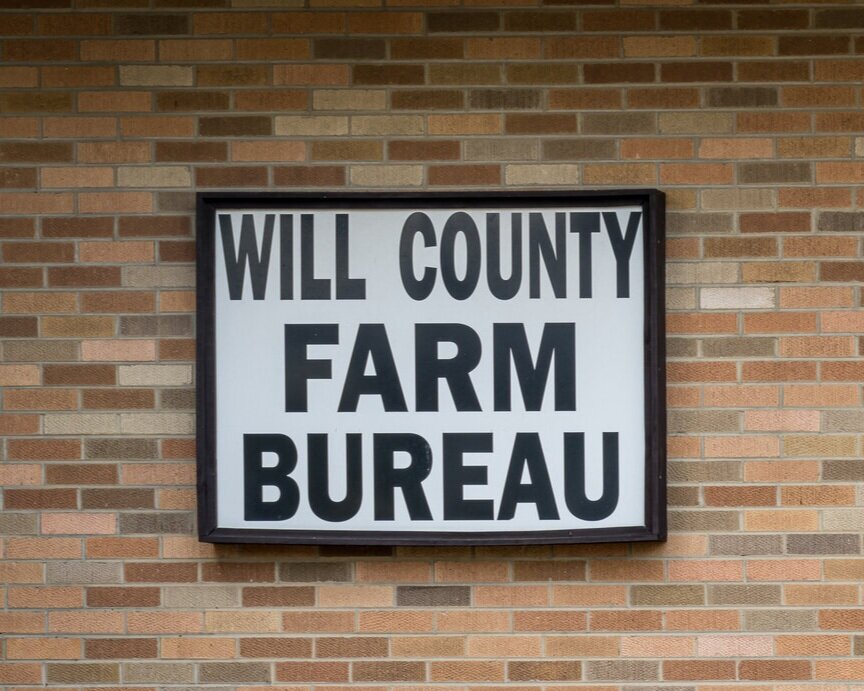

Will County Farm Bureau Joliet, IL
This cluster of buildings is the home of the Will County Farm Bureau.
The Farm Bureau was started in 1913 by a group of local farmers. The first name was Will County Soil and Water Association and they occupied the Woodruff office building which still stands today off Chicago and Jefferson Streets. The organization grew to represent 3,588 farms by 1918. In 1919, the name was changed to Will County Farm Bureau. After World War I, many new issues arose. Railroad deliveries of farm commodities needed modernization. The European corn borer was decimating crops. The Farm Bureau assisted in the development of hybrid corn. We celebrated our 100th anniversary in November 2013 with over 490 people in attendance and have continued to work with local farmers. We Advocate for Agriculture, and represent and protect rural needs while upholding farm values. The Farm Bureau’s Barn Quilt is Folded Flag and was painted by the Arts Guild of Homer Glen and delivered in 2020.
Barn Quilt Design: Folded Flag
The operating staff is housed in this building, as well as meeting rooms for members, and a small gift shop.

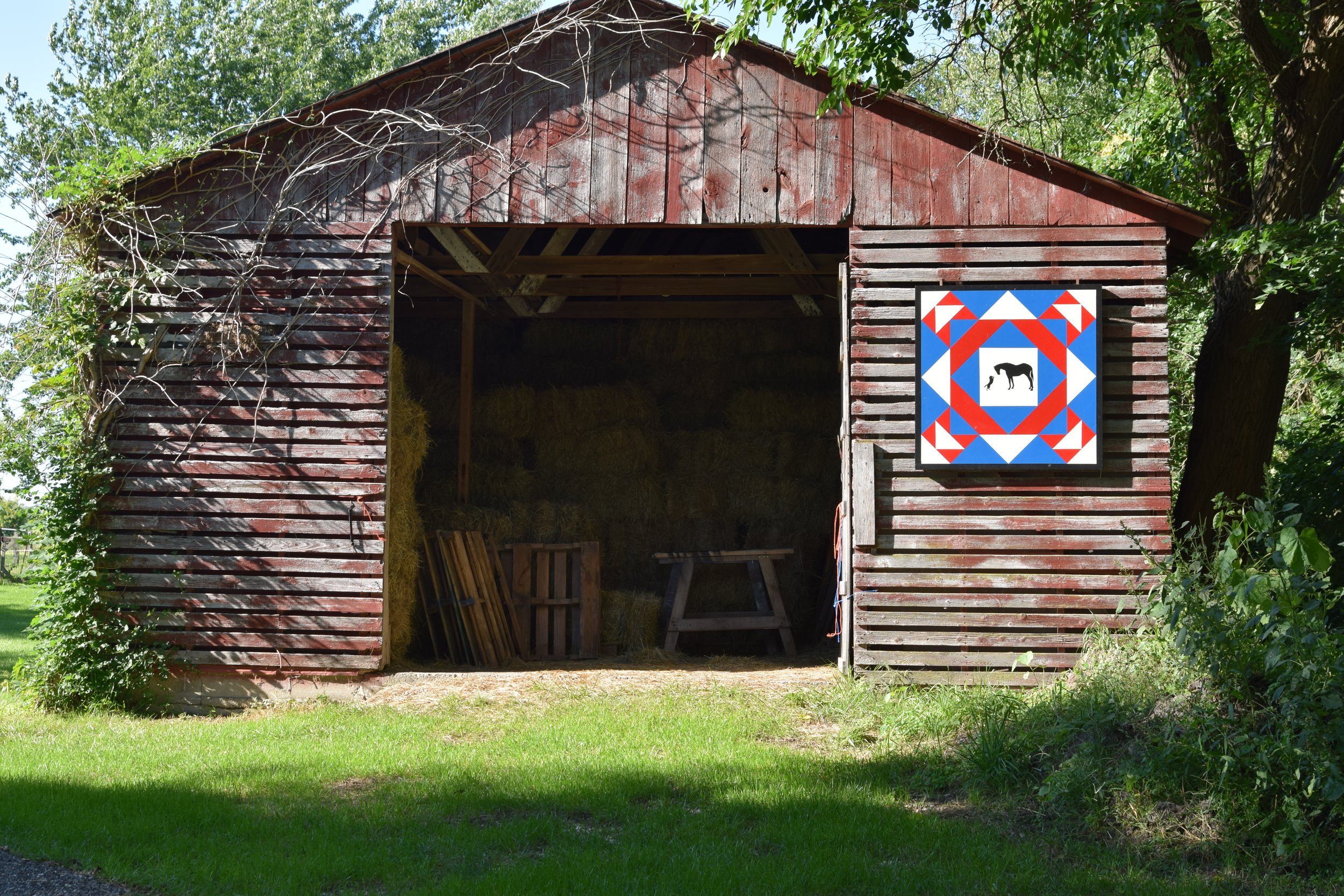
Whispering Woods Farm, Frankfort, IL
Sue and Dan Panozzo bought this small farm over forty years ago. They raised their two sons here. Sue’ s horse “Whisper” lived to over forty years old. Her next horse “Rusty” recently passed. The Panozzo’s take care of a couple of horses with medical problems that require special care. Six acres are in hay to provide for the horses.
The Barn Quilt is Labyrinth and was painted by the Arts Guild of Homer Glen and delivered in 2023.
Barn Quilt Design: Labyrinth
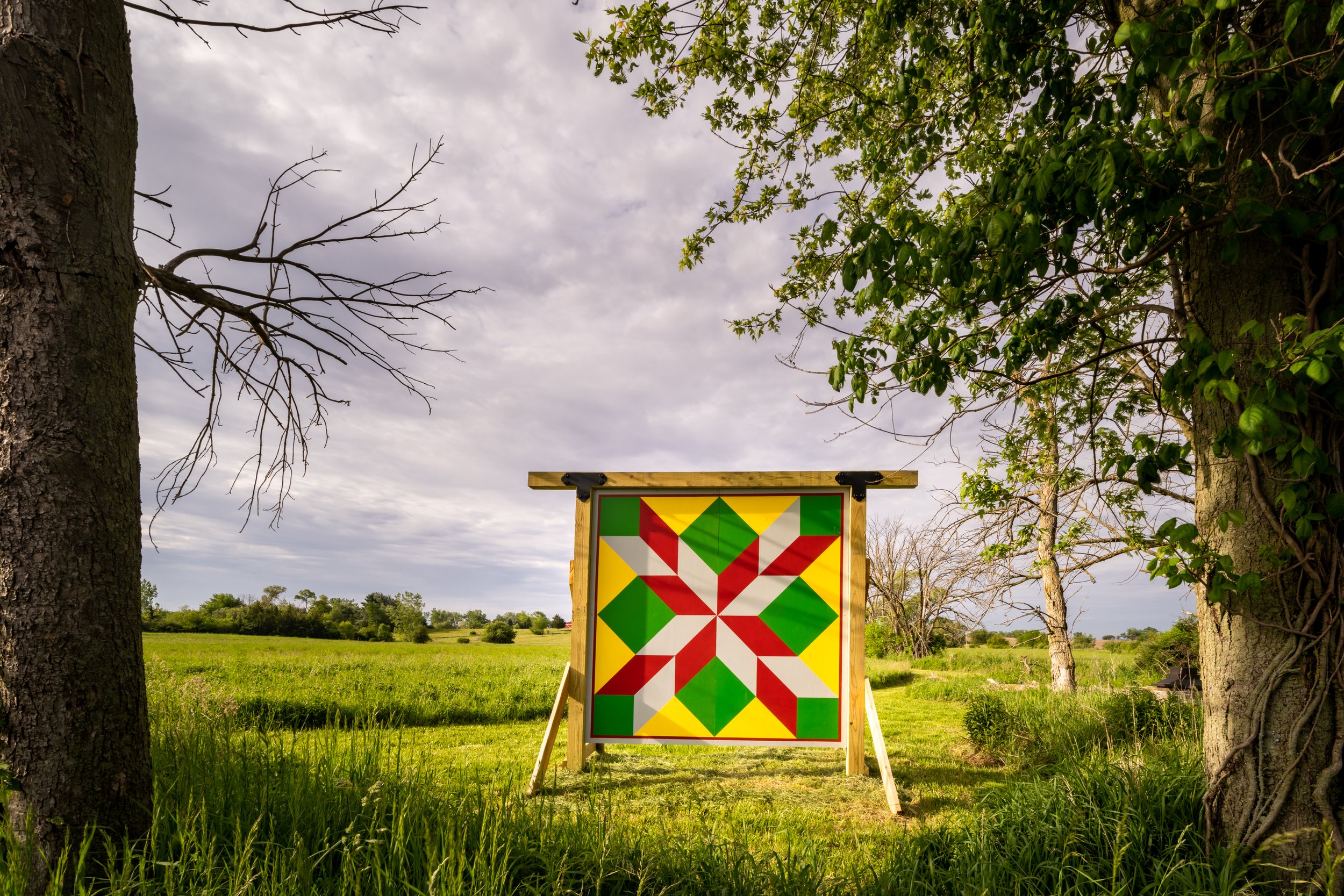




Anonymous
Will County , IL
These Barn Quilts are on private property. The owners are not participating in the Barn Quilt Trail.
They were painted by the Arts Guild of Homer Glen and delivered 2020 -2024.
Barn Quilt Designs:
Love in the Mist
Tractor
Pumpkin Spice
Corn and Beans
Constellation
